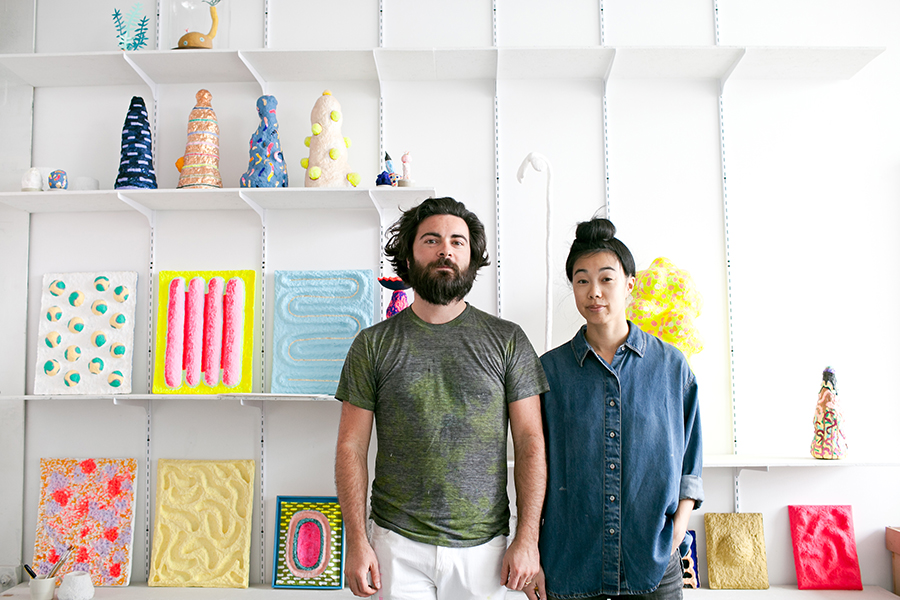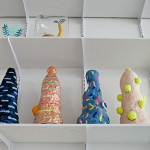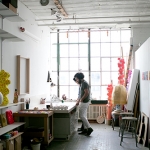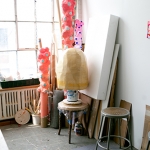Adam Frezza and Terri Chiao have a loft built into their Bushwick loft. Inside the brick-laid standards of New York City’s architecture exists the artistic duo’s oasis—an interior retreat disconnected from the rest of their urban living space. Between the shared efforts of carpenter and designer, the creative living environment has evolved with the pair as a formative backdrop to their artistic headway. Just one instance of their self-aware inspirations.
Autonomously—as Chiao and Frezza, respectively— they contribute their talents to the arts just as seamlessly as they do together, but their collaborations are made possible by a shared creative reliance on play and the hands-on trial and error of their imaginative crafts. CHIAOZZA’s creations—paintings, photographs, sculptures, installations and collages—grip to the spontaneity of interactive actualization, curiously espied in rousing colors and mold-free forms. Assorted in scale, resource and connected environment, their work transcends that of wonted construction, free of expectations, and compelled by curiosity.
Who is CHIAOZZA? [pronounced “chowza”]
The name is the two of our names put together, or parts, anyway. It originally came about as a way to give some of the work we were doing [together] a separate life from the work we were doing as Adam and Terri. Over the years things have become very blurry and over time we’ve come to embrace that. In some ways, we don’t see our work as separate as we used to.
At first it was a creative protection measure. In the design world everything is expected to work right away, and in art, most things fail, so we wanted to make sure that there was room for both.
A: I’m a frustrated carpenter. I went to school for drawing and painting and always really loved the struggle of building the canvas—before i would get to the painting the process felt like it was already starting. So, I got really interested in the sculptural aspects of the painting. A sculptor who’s got a little training in painting and drawing.
T: I’m an artist and designer. I have a background in architecture, I went to school for architecture. I design a lot of different things: signage, lighting, things like that. I think that place was a good place for me to be but then it allowed me to realize that I wanted a lot more even more freedom and possibilities. When I left that world, Adam and I met and it was good time; we realized that we shared creative interests. We both work with pairing colors, but also in the spirit of the work that we’re making: in the immediate experience as a spacial designer.
What are your earliest memories of art and art-making? What about the playful act of creating/crafting holds importance for you?
A: as a kid, I can remember loving to draw. I can’t remember specifics. I colored the bottom of my dads feet black. Drew on the walls with my poo and called it “Charlie Brown.” It was impossible for my parents not to notice—I was always using stuff. I have a memory of sitting [in the car] outside of a building with a weird sculpture outside. And my dads outside talking to a woman, and she’s shaking her head no —it’s an art school, and she said I was too young, and I said that’s OK.
He was really upset that she wouldn’t allow me to foster my creativity. It’s a good memory, because opposition does exist and my early work was usually about opposition as an inspiration to carry on.
T: When I was around ten, my parents redid their backyard, and seeing that process was really interesting because everywhere you looked there was some sort of material lying around: scraps and geometrical pieces of wood. It was easy for a kid to get lost in that setting. As I got older and had more interest in how to improve my life, that’s what I did: as a teen I took apart clothing and stitched it back together to make interesting pieces. I also repainted my furniture at night. It’s always been this idea of finding projects for yourself and doing them. For me, it’s comforting and natural part of my being.
A: It’s a common ground we share. We live together, and we’re constantly allowing ourselves a new project in the house. Making the time to keep growing your living environment is something that can start from a young age and I was lucky enough my parents let me strip the stain off all my furniture because it was too dark. It’s a great experience, empowering to see something change before you. We kind of do that all the time in our apartment. Before I met Terri, she built a cabin in the loft with a peaked roof and two windows. It’s kind of always under construction—we’re moving things constantly. It’s immediately a playful environment to wake up to and build and grow.
What is your creative process like? Do you ever work separately? How do your ideas come together? And what is your workspace like? (messy, hectic, organized, music playing, friends around, etc.)
T: A lot of our projects emerge from dialogue that we have together, sometimes stemming from experiences, like walking in the woods or something and looking at the trees like, woah, it would be cool to do some play on that if they we’re all frozen… I think the act of being out in the world and looking at things is like an open space for your mind to move around together, to come up with ideas together, to decide how to start going about it.
A lot of our work addresses play and the concept of play in a lot of different ways. One way, aside from colors and shapes, is using the idea of play as a structuring tool for how to work together. Take, for instance, playing catch, and the rules are that there’s a ball and one person throws it to the other person, and so it goes, back and forth until you don’t want to play any more. We set up some sort of rules which we can work under or within but with our own freedom.
A: Setting up a game and seeing how that game leads us to work that we wouldn’t otherwise make on our own. I love the moments when we start to forget who thought of something and loosen that ownership. That play aspect sets up a certain rigor so that we’re not just playing all the time; our play has some scheduling. We call it our class schedule. We might go for a walk and talk about ideation—those walks can be very productive and we’ll get on the same page, like this is it, this is the one; lets move forward. And that gets us excited to get back to the studio—get back to “class”—and start working. The idea of this class schedule allows us something to look forward to. We don’t have to work on that one project all day long. we need that hour of study hall to investigate our own projects or things we haven’t finished.
T: When we go on residencies separately, we have sort of established a rhythm that works for us. Adam might make a series of paintings, or I might go around and collect things. That kind of freedom is important to our freedom, because we’re still growing our own ideas separately, then we can bring back to the collective as a collaborative team. In 2013, Adam made a series of colored stones—“Sticks & Stones”—and photographed them on black and white paper. That project itself is really beautiful as a photo series, but we then, together, took that idea and applied it to our first public art sculpture. We basically evolved that idea into something really large at the University of Florida. The process lasted two years until constructed—with “Cairn,” we were transforming that idea and building a new project.
A: I may have never stacked them on my own. I find with her architecture background, we might make something small in studio not thinking of it as a model, but her history in architecture gives anything the potential to be a large-scale object. We’ve been kind of controlling that a little bit. we want to make dioramas or small scale models of ideas we have; not wait for the ideas to come, but guide it a little bit more through that process.
You work across a wide range of mediums and materials. How does that creative decision making work—material shapes idea or idea shapes material?—and how does your process differ per different “canvas.”
A: Initially, it comes down to availability. What’s easy to obtain. Our Wooden CHIAOZZA shelves, those are achieved by slats of wood we can buy at an art shop. With, then, for “Paper Plants,” we noticed we were getting junk mail from places and we didn’t know why they were sending us all this paper. So, we’ve been taking this paper, shredding it and making a pulp. It costs us next to nothing, just bringing it to a workable form. It’s neat to see something come from nothing; it would be litter if we didn’t. Recycling is important. Doing that ourselves also leads to other projects—so much paper pulp! We started building little screens for paper making and press pulp into it and rather than try to achieve flat paper. We make these lumpy papers and are now in the midst of a series of lumpy paper. The process starts when I check my mail, because I’m looking for more material.
T: A lot of times, we really like the immediacy of our process. We can work directly with no heavy equipment, and in that way there’s immediacy that we hope comes across as an immediacy in experience. The lumpy paper stuff is an interesting texture right off the bat, and even tho we’ll paint those surfaces, you’re looking at it and wondering where it came from. It’s interesting and a nice challenge, too.
The natural world appears in most of your work (if not in concept, in location or modality). Speak a little about that guiding importance and what environmental appeal you aim to communicate in your work.
A: That sense of discovery on a walk through nature—I might be more sensitive to it now as an adult living in New York and I get out of city into and nature. The weirdness and awe is heightened for me. Take an otherwise boring object, like a rock, and I’m suddenly mesmerized by its sparkle or shape. We collect a lot on our walks, but we try to be selective, thinking in terms of art objects. When you go to a museum or show, that awe of an object feels really nice, and by being loose in dialogue with that intention and practice I hope that maybe we can contribute this weird object to blow someone else’s mind.
T: I think it’s important to feel connected to our environment—it could be our natural environment or our apartment or the community—and I think that sharing that connection is something that is important to us as well. We did a project with Biome Arts and built a projection hut in the woods as a platform for artists to do other things like art performance, music, etc. The way we went about building the hut was very engaging—to get there we had to walk through meadow, take off our shoes, etc. That ritual of it sets in the importance of environment and creates the space as a sacred space. I think that it was a powerful experience for a lot of people involved, not just because it was in a peaceful place in the woods, but it exists as something immediate as a very beautiful thing. If we can share that with people and if people can have that experience and take with them and continue to live their lives, that would be an amazing accomplishment.
As a collaborative duo, what is your opinion of the NYC arts scene? Is it collaborative?
A: More and more we find that the shows we have within the art crowd feel a certain way, and shows in design feel a certain way. Right now, design feels collaborative. For example, our friend Alex Proba reached out not knowing what to do, but we met and started a dialogue and made collages. None of us could have gotten here without one another, and that feels really refreshing.
T: Our scene in New York is more in the fine art world. There are galleries everywhere, but I think that because we’re in Bushwick, working and living within two blocks, and the building our studio is in is almost all artists and galleries, we have a positive experience in the Bushwick scene because it’s so dense in a lot of ways. There are more and more great galleries and open studios here and Bushwick has fostered a great sense of community. For that I am appreciative.
for more CHIAOZZA, follow them on Instagram or at Uprise Art.
photos by Jen Brister










